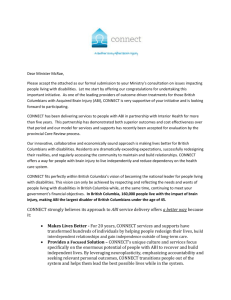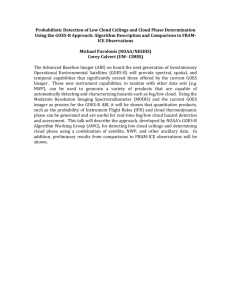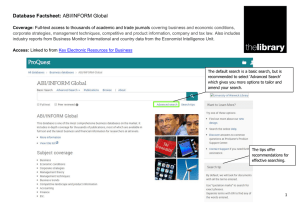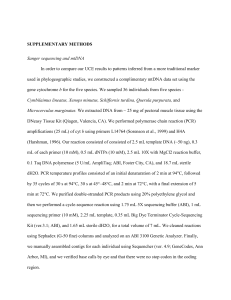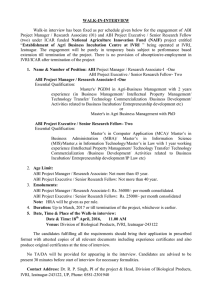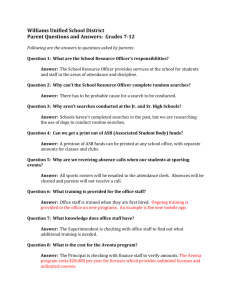STUDY OF THE ADVANCED BASELINE IMAGER (ABI) ON THE GOES-R AND BEYOND
advertisement
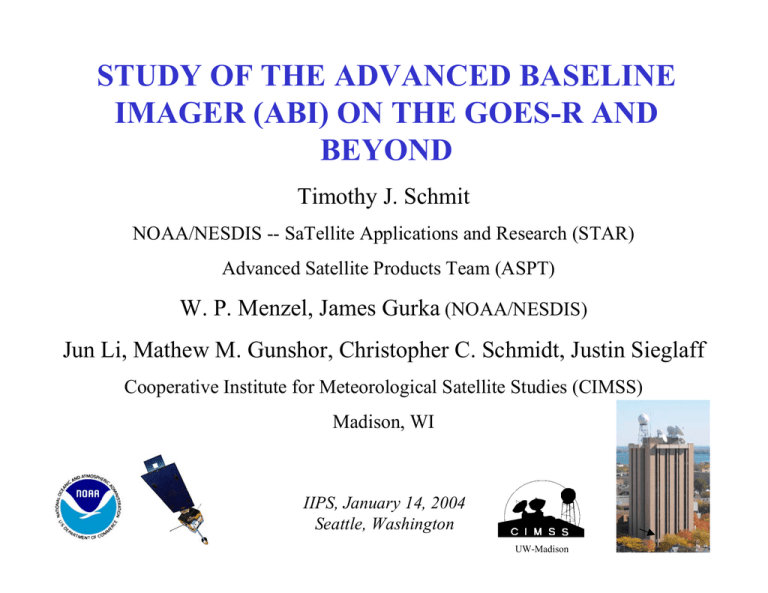
STUDY OF THE ADVANCED BASELINE IMAGER (ABI) ON THE GOES-R AND BEYOND Timothy J. Schmit NOAA/NESDIS -- SaTellite Applications and Research (STAR) Advanced Satellite Products Team (ASPT) W. P. Menzel, James Gurka (NOAA/NESDIS) Jun Li, Mathew M. Gunshor, Christopher C. Schmidt, Justin Sieglaff Cooperative Institute for Meteorological Satellite Studies (CIMSS) Madison, WI IIPS, January 14, 2004 Seattle, Washington UW-Madison Outline • What is the Advanced Baseline Imager (ABI)? • Summary of the Spectral Bands – Visible/near infrared – Infrared – Recent changes • Relationships between bands and select products • Summary • More information – – – – Limitations of Current GOES Imagers Missing spectral bands Low spatial resolution Regional/Hemispheric scan conflicts Eclipse and related outages The ABI (Advanced Baseline Imager) is the next generation operational geostationary imager. The GOES-R/ABI era will begin in 2012. The Advanced Baseline Imager: ABI Current 16 bands 5 bands Spectral Coverage Spatial resolution 0.64 µm Visible 0.5 km Other Visible/nearIR 1.0 km Bands (>2 µm) 2 km Approx. 1 km n/a Approx. 4 km Spatial coverage Full disk CONUS Every 3 hours ~4 per hour 4 per hour 12 per hour Visible and near-IR channels on the ABI H az e Cl ou ds Ve g. ize Pa rt. s w, Sn o Ci rru s Ph a se AVIRIS spectra The current GOES has only one visible band. IR channels on the current GOES and on the ABI The spectral coverage of the ten IR ABI bands. Spectral coverage from the GOES-12 imager and a sample high-spectral resolution earth-emitted spectra. Weighting Functions for the IR channels on the ABI Weighting functions for the standard atmosphere at a local zenith angle of 40 degrees. Data needed to realistically simulate the ABI Attribute Instruments Spatial resolutions (IR) MODIS (no 10.35 µm) Spatial resolutions (Vis/nearIR) Spectral widths (IR) MODIS AIRS (no 8.5 µm, spectral gaps) Spectral widths (IR) Aircraft NAST-I Spectral widths (Vis/nearIR) Aircraft AVIRIS Temporal aspects Current GOES in special mode Spatial & spectral & temporal None. ABI Bands Future GOES Imager (ABI) Band 1 2 3 4 5 6 7 8 9 10 11 12 13 14 15 16 Wavelength Range (µm) Central Wavelength (µm) Sample Objective(s) 0.45-0.49 0.59-0.69 0.84-0.88 1.365-1.395 1.58-1.64 2.235 - 2.285 3.80-4.00 5.77-6.6 6.75-7.15 7.24-7.44 8.3-8.7 9.42-9.8 10.1-10.6 10.8-11.6 11.8-12.8 13.0-13.6 0.47 0.64 0.86 1.38 1.61 2.26 3.90 6.19 6.95 7.34 8.5 9.61 10.35 11.2 12.3 13.3 Daytime aerosol-over-land, Color imagery Daytime clouds fog, insolation, winds Daytime vegetation & aerosol-over-water, winds Daytime cirrus cloud Daytime cloud water, snow Day land/cloud properties, particle size, vegetation Sfc. & cloud/fog at night, fire High-level atmospheric water vapor, winds, rainfall Mid-level atmospheric water vapor, winds, rainfall Lower-level water vapor, winds & SO 2 Total water for stability, cloud phase, dust, SO2 Total ozone, turbulence, winds Surface properties, low-level moisture & cloud Total water for SST, clouds, rainfall Total water & ash, SST Air temp & cloud heights and amounts Based on experience from: Current GOES Imagers ABI Bands Future GOES Imager (ABI) Band 1 2 3 4 5 6 7 8 9 10 11 12 13 14 15 16 Wavelength Range (µm) Central Wavelength (µm) Sample Objective(s) 0.45-0.49 0.59-0.69 0.84-0.88 1.365-1.395 1.58-1.64 2.235 - 2.285 3.80-4.00 5.77-6.6 6.75-7.15 7.24-7.44 8.3-8.7 9.42-9.8 10.1-10.6 10.8-11.6 11.8-12.8 13.0-13.6 0.47 0.64 0.86 1.38 1.61 2.26 3.90 6.19 6.95 7.34 8.5 9.61 10.35 11.2 12.3 13.3 Daytime aerosol-over-land, Color imagery Daytime clouds fog, insolation, winds Daytime vegetation & aerosol-over-water, winds Daytime cirrus cloud Daytime cloud water, snow Day land/cloud properties, particle size, vegetation Sfc. & cloud/fog at night, fire High-level atmospheric water vapor, winds, rainfall Mid-level atmospheric water vapor, winds, rainfall Lower-level water vapor, winds & SO 2 Total water for stability, cloud phase, dust, SO2 Total ozone, turbulence, winds Surface properties, low-level moisture & cloud Total water for SST, clouds, rainfall Total water & ash, SST Air temp & cloud heights and amounts Based on experience from: Current GOES Imagers MSG/AVHRR/ Sounder(s) ABI Bands Future GOES Imager (ABI) Band 1 2 3 4 5 6 7 8 9 10 11 12 13 14 15 16 Wavelength Range (µm) Central Wavelength (µm) Sample Objective(s) 0.45-0.49 0.59-0.69 0.84-0.88 1.365-1.395 1.58-1.64 2.235 - 2.285 3.80-4.00 5.77-6.6 6.75-7.15 7.24-7.44 8.3-8.7 9.42-9.8 10.1-10.6 10.8-11.6 11.8-12.8 13.0-13.6 0.47 0.64 0.86 1.38 1.61 2.26 3.90 6.19 6.95 7.34 8.5 9.61 10.35 11.2 12.3 13.3 Daytime aerosol-over-land, Color imagery Daytime clouds fog, insolation, winds Daytime vegetation & aerosol-over-water, winds Daytime cirrus cloud Daytime cloud water, snow Day land/cloud properties, particle size, vegetation Sfc. & cloud/fog at night, fire High-level atmospheric water vapor, winds, rainfall Mid-level atmospheric water vapor, winds, rainfall Lower-level water vapor, winds & SO 2 Total water for stability, cloud phase, dust, SO2 Total ozone, turbulence, winds Surface properties, low-level moisture & cloud Total water for SST, clouds, rainfall Total water & ash, SST Air temp & cloud heights and amounts Based on experience from: Current GOES Imagers MSG/AVHRR/ Sounder(s) MODIS/MTG/ Aircraft, etc Shortened the shortwave side of the 6.15 µm (wide) water vapor band to be more consistent with GOES-12+ Imagers and MSG. Changed from 5.7 – 6.6 µm to 5.77 to 6.6 µm. ABI 6.2 µm Band (NASTI data) ABI 6.2 ABI 6.2 µm - 6.2 µm adjusted X 10 ABI 6.2 adjusted SO2 calculations from F. Prata Slightly shift, toward larger wavenumbers, the two narrow ABI water vapor bands to better discriminate the SO2 peak. ABI Water Vapor Band Differences convolved from AIRS data (SO2 plume from Montserrat Island, West Indies ) Difference of left and right images ABI 7.4 µm - 7.0 µm ABI 7.34 µm - 6.95 µm (“shifted”) Spectral widths of the previous (narrow) and new (wide) ozone band on the ABI. The spectral tolerances are shown for the ABI. Spectral bandwidths from other sensors and an earth-emitted spectra are also plotted. Select Products clouds/fog aerosol products cloud phase, cloud particle size snow, ice volcanic ash/ SO2 land/sea surface temperature atmospheric motion fires cloud height/emissivity haze/dust NDVI (Normalized Difference Vegetation Index) severe weather signatures turbulence ozone radiances, cloud mask rainfall Products that are highlighted are included in this talk Three-color composite (0.64, 1.6 and 11 µm) shows the low cloud over the snow and the water versus ice clouds. Snow Low cloud Volcanic Ash Plume: 11-12 and 8.5-11 µm images One day after the Mt. Cleveland eruption 20 February 2001, 0845 UTC Simulated ABI (11-12 µm) Simulated ABI (8.5-11 µm) UW/CIMSS Aerosol Transport Model Assimilation of the Wildfire ABBA Fire Product Using the Navy Aerosol Analysis and Prediction System FIRES GOES-8 Wildfire ABBA fire product for the Pacific Northwest Date: August 17, 2001 Time: 2200 UTC Smoke NAAPS Model Aerosol Analysis for the continental U.S. Date: August 18, 2001 Time: 1200 UTC ABI “Natural Color” Image (from MODIS) This represents a “best case” for generating an “natural color” RedGreen-Blue” composite image, given the MODIS 550 nm data from this image was used to build the Look Up Table (LUT) to simulate the “green” component from the other spectral bands. The HES-Coastal Water will have a 550 nm band. Hurricane Isabel on September 18, 2003 from MODIS 13.3 µm allows for better cloud-top information estimates GOES-12 Imager -- Cloud Top Pressure Utility of the 0.86 µm band • Useful in determining vegetation amount, aerosols, and for ocean/land studies. • Enables localized vegetation stress monitoring, fire danger monitoring, and albedo retrieval. • Provides synergy with the AVHRR/3 and VIIRS. AVIRIS data: SCARB_0.85µm Mountain Waves in WV channel (6.7 µm) 7 April 2000, 1815 UTC Simulated ABI Actual GOES-8 Mountain waves over Colorado and New Mexico were induced by strong northwesterly flow associated with a pair of upper-tropospheric jet streaks moving across the elevated terrain of the southern and central Rocky Mountains. The mountain waves appear more well-defined over Colorado; in fact, several aircraft reported moderate to severe turbulence over that region. Both images are shown in GOES projection. UW/CIMSS Fog -- Based on GOES Imager 3.9 µm 5 March 2001 - Nocturnal Fog/Stratus Over the Northern Plains GOES-10 4 minus 11 µm Difference Both images are shown in the GOES projection. ABI 4 minus 11 µm Difference Fog UW/CIMSS ABI image (from MODIS) shows greater detail in structure of fog. Higher Spatial Resolution GOES Channels Simulated ABI concentric anvil(from MODIS) layer waves Enhanced “V”: IR windows May 25, 2000 Enhanced “V” Actual GOES http://cimss.ssec.wisc.edu/goes/misc/000525.html Best products will be realized from combinations of ABI and HES (Hyperspectral Environmental Suite) data (IR and Visible/near IR on the HES-Coastal Water)! Spatial resolution Temporal resolution Cloud clearing ABI HES Surface emissivity Spectral coverage Spectral resolution Summary -- ABI ABI addresses Imager concerns by: • increasing spatial resolution - closer to NWS goal of 0.5 km IR • scanning faster - temporal sampling improved - more regions scanned • adding bands - new and/or improved products enabled Simulations (from MODIS, AIRS, NAST-I and AVIRIS) show that the ABI addresses needs for cloud, moisture, and surface products. Every product from the current GOES imager will be improved (for short-term weather, environmental and climate applications)! Every band on the ABI will be used for a number of products. ABI will allow exciting new products from geostationary orbit, especially when combined with data from the HES. More information -- ABI ABI Documentation from NASA: • http://goes2.gsfc.nasa.gov/abihome.htm ABI Research Home page: • http://cimss.ssec.wisc.edu/goes/abi/ ABI Simulated images from NASA AIRS Direct Broadcast: • http://cimss.ssec.wisc.edu/goes/abi/airs_broadcast/aniairs.html GOES(-R) User Conferences (Third one will be May 10-13, 2004): • http://www.osd.noaa.gov/announcement/index.htm GOES and MODIS Galleries: • http://cimss.ssec.wisc.edu/goes/misc/interesting_images.html • http://terra.ssec.wisc.edu/~gumley/images.html ABI Mock Spectral Response functions: • ftp://ftp.ssec.wisc.edu/ABI/SRF This slide is (mostly) blank.
